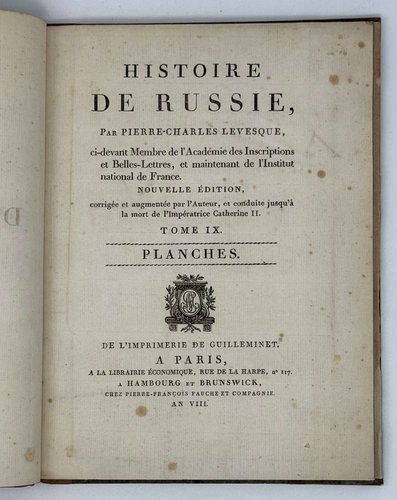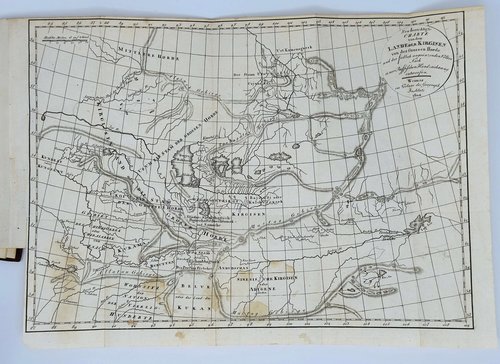


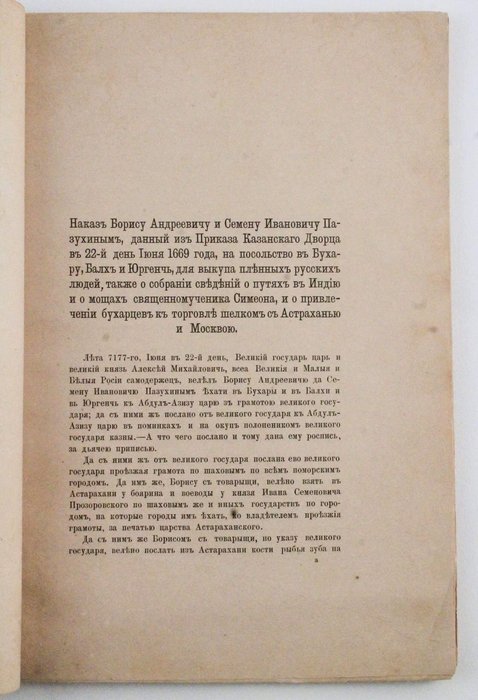
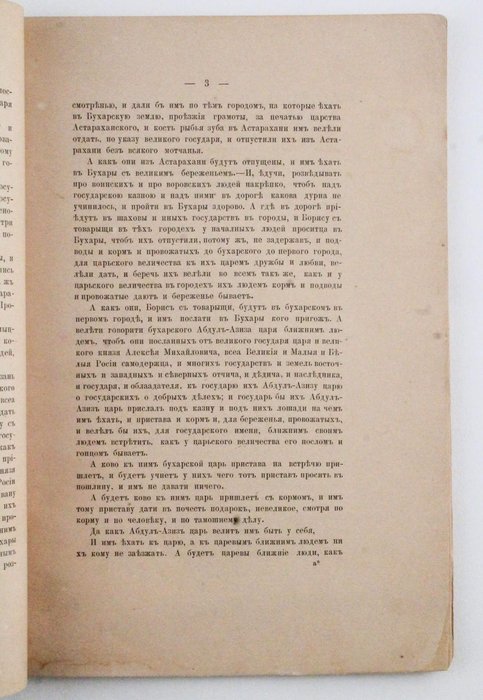
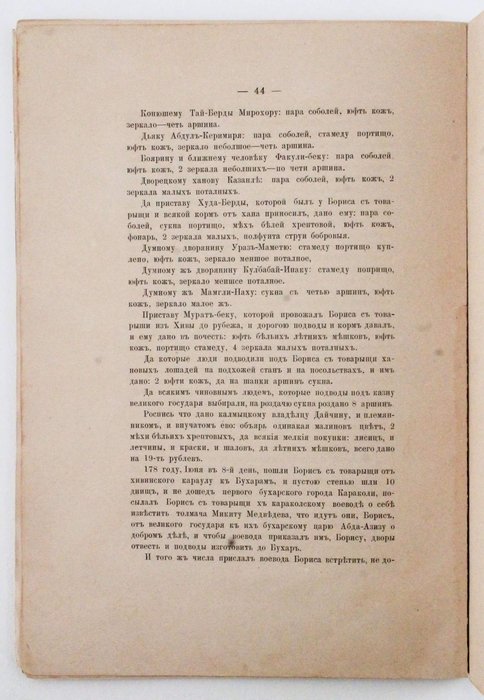
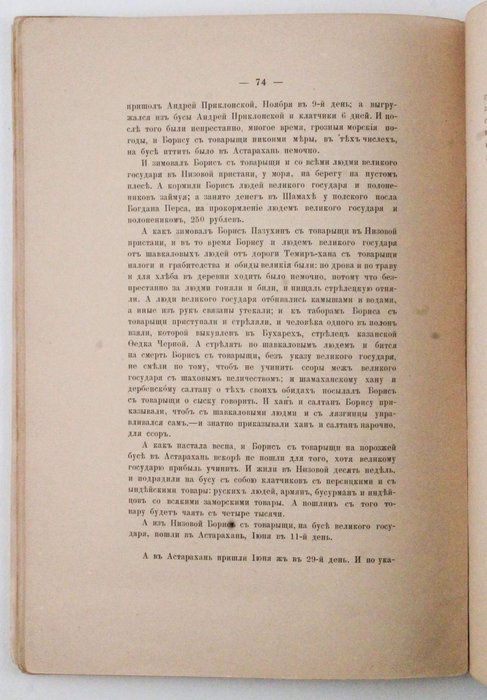
#RA12
1894
First and only edition. Large Octavo (ca. 26,5x18,5 cm). [2 – t.p.], 91 pp. Original publisher’s wrappers. Wrappers and the title page with minor losses on extremities neatly repaired, paper slightly age-toned, otherwise a very good original copy.
Very rare Russian imprint with only five paper copies found in Worldcat (Harvard University, Columbia University, Humboldt University of Berlin, Free University of Berlin, Jagiellonian University in Krakow). First and only publication concerning Russian Tsar Alexey Mikhailovich’s embassy to Khiva and Bukhara in 1669-1673. The book contains the texts of twelve original manuscripts from the Chief Moscow Archive of the Ministry of Foreign Affairs (now a part of the Russian State Archive of Ancient Documents or RGADA), published by the Imperial Archaeographic Commission under the supervision of its member, Askalon Nikolaievich Truvorov (1819-1896). The book was not translated into other languages or republished in Russia.
The embassy, led by two members of a noble Russian family of Pazukhins, Boris Andreievich and Semen Ivanovich, aimed to ransom and return Russian captives in Khiva and Bukhara, collect intelligence about trade routes to India and find out about the relics of a 4th century AD Christian martyr, St. Simon, Bishop of Seleucia/Ctesiphon (then Sasanian Empire, modern-day Iraq), which were said to be kept in a church near Shamakhi (then Safavid Empire, modern-day Azerbaijan). The Pazukhins went from Moscow via Kazan and Astrakhan, visited Khiva, where they had an audience with the Anusha Khan, and then proceeded to Bukhara. They stayed there for several months, had several audiences with Abd al-Aziz Khan (ruled in 1645-1680) and collected intelligence about relations between the rulers of Khiva, Bukhara, Balkh, Persia and India, their armies, finance, trade routes and silk production. On the way back, the embassy went via the territory of the Safavid Empire, visiting Merv (Mary), Meshet (Mashhad), Baku and Shamakhi and then sailing back to Astrakhan.
The book contains texts of twelve larger or smaller manuscripts dedicated to the embassy. Among them are: 1) Tsar’s Instruction to Boris and Semen Pazukhins, from June 22, 1669… (pp. 1-21); 2) A letter from Astrakhan Voivodas [military commanders], prince Ivan Semenovich Prozorovsky with comrades, accompanying three pleas from Russian captives in Bukhara (pp. 21-24); 3) Tsar’s Gramota [official letter] to Khan Abd al-Aziz of Bukhara about dispatching ambassadors Boris and Semen Pazukhins for the release of Russian captives from Bukhara (pp. 24-27); 4) Tsar’s Gramota to the Shah of Persia to permit the Pazukhins to travel through Persian cities… (pp. 27-28); 5) Tsar’s Travel Gramota to khans, voevodas, princes and officials of the Persian and Shirvan lands to permit free passage for Pazukhin and his party (pp. 29-30); 6) Tsar’s Gramota to a Kalmyk chief Daichin to provide guides to Bukhara for Pazukhin’s party (pp. 3-31); 7) Travel Gramota to boyars and voevodas of the cities on the way from Moscow to Astrakhan to assist Pazukhin’s party (pp. 31-32); 8) Gramota to Saratov voevoda Ivan Vasil’evich Samarin to assist Pazukhin’s party (pp. 32-33); 9) Stateinyi Spisok [Report] of ambassadors to Bukhara, Balkh, Khiva and Urgench, Boris Pazukhin with comrades, on the matter of ransom for the Russian captives, from June 22, 1669 to June 29, 1673 (pp. 33-75); 10) A statement of what [presents] was sent from Moscow by the Tsar’s decree to Bukhara and other places (pp. 75-80); 11) A translation of a Turk letter from Khan Abd al-Aziz of Bukhara to Tsar Alexey Mikhailovich (pp. 80-81); 12) An extract from the file of ransom and release of Russian captives from Bukhara, Balkh, Urgench and Khiva, through ambassadors Boris and Semen Pazukhins and comrades (pp. 81-86).
The text of Pazukhin’s Report also contains a translation of a letter from Subhan Quli Khan of Balkh (1625-1702), to whom a member of Pazukhin’s party, translator Mikita Medvedev, was sent with a secret mission (pp. 64-65). There is also a detailed description of the tomb of a saint near Shamakhi, who was considered by Muscovites to be St. Simon of Persia. The site is Diri Baba Mausoleum on the road between Baku and Shamakhi, modern-day Azerbaijan. The book is supplemented with an alphabetical index of personal and geographical names. Overall an important rare publication on the history of diplomatic relations between Russia and Central Asian khanates in the 17th century.







